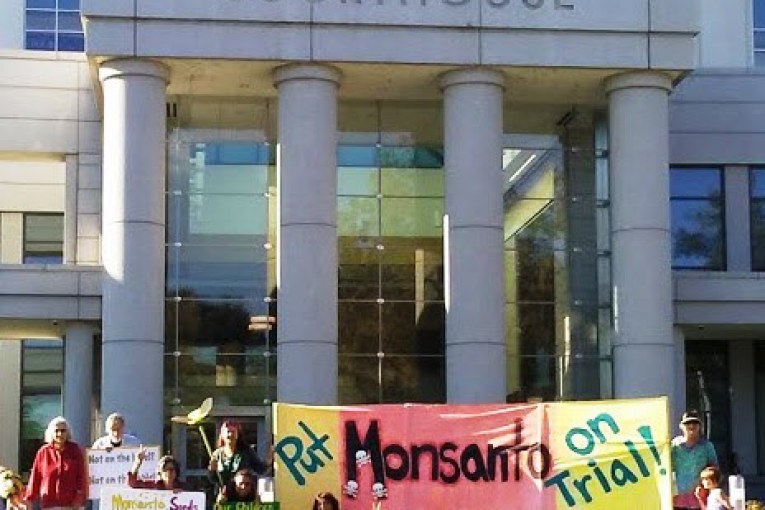
 By Crescenzo Vellucci
By Crescenzo Vellucci
Defendants in the so-called “Monsanto 10” case here are demanding the Yolo County Sheriff’s Office and Yolo County District Attorney disclose detailed discovery ahead of a Dec. 4 trial – defendants suggested they are searching for evidence of “collusion” between one or more county agencies and Monsanto to deny the demonstrators their constitutional rights.
“These are exculpatory records. We want them, and we want them now,” said Bob Saunders, one of the defendants in the case.
The requests follow a September pre-trial in which the defendants plead not guilty when the DA decided to proceed with the case in traffic court, which eliminated the chance for a jury trial. Defendants said it was an attempt to torpedo their plans to “put Monsanto on trial” because the Dec. 4 trial will now only be heard by a judge.
The “Monsanto 10,” environmental and social justice activists from Grass Valley, Sacramento, other parts of Northern California and as far away as New York, were arrested and jailed at a protest at Monsanto’s huge plant here May 22. They were arrested on multiple misdemeanor charges but only charged by the DA with “loitering.”
They are threatening, it appears, to turn the usual hum-drum traffic court proceedings into a three-ring circus. In short, a real trial.
In the September pre-trial Sacramento defendant Saunders gave a hint of what could come, charging, “The Yolo County Court is doing Monsanto’s bidding, robbing us of a constitutionally guaranteed 
trial before a jury of our peers. We want the opportunity to show the jurors, and the world, how Monsanto should be on trial for violating the planet and killing people.”
In letters of demand sent this week to the DA and sheriff, Saunders and other defendants, who are representing themselves (pro bono attorney Rich Dudek, recruited by the National Lawyers Guild of Sacramento, is representing one defendant), are asking for a “video” that the incident report hinted existed but has never been produced.
In fact, Saunders’ demand letter asks for “all body, dash cam” and other videos.
The official report also references discussions with Monsanto, and Saunders says he wants to see any “emails…notes and reports…any and all communication, written or otherwise…including tweets, emails meetings, phone conversations” between Monsanto and their “agents…pertaining to the protest/rally and the arrests” and the DA’s office or the sheriff’s office.
His demand letters also ask for the standard dispatch logs and a complete list of all sheriff’s officers, California Highway Patrol and Woodland Police Dept. personnel at the protest.
Dudek has said he has serious questions about the constitutionality of the charged infraction (loitering on a public highway or sidewalk, Section 5-5.01 of the Yolo County Code) and said he is researching its application in a 1st Amendment setting.
The Woodland demonstration last May was part of more than 400 “Anti-Monsanto/Anti-GMO” demonstrations worldwide in 47 states and 52 countries on six continents. Activists’ battle cry was that world regulatory organizations have declared Monsanto’s glyphosate-containing Roundup herbicide is a “serious threat to health. ”
The Woodland Monsanto plant is known to be the world’s largest biotech seed facility in the world, activists said. Monsanto controls 92 percent of the world’s seed market and conducts genetic engineering (GE) which produces genetically modified foods (GMOs) which reportedly have been tied to health and safety issues, say activists.
The World Health Organization, activists said, called Roundup a ‘probable carcinogen’ in the food supply. WHO said glyphosate has been detected in groundwater supplies and 60-100 percent of rainwater collection samples in various parts of the world.
Activists also said that GMOs are partially banned in many countries, including Germany, Green, Ireland, Japan, Russia, adding that more than 60 countries require GMO labeling – but not the U.S., although some surveys say more than 95 percent of Americans would approve GMO labeling.
According to a fact sheet provided by the Woodland “Monsanto 10,” glyphosate is the most widely used pesticide in California and in the U.S. – “more than 280 million pounds were used in U.S. agriculture, primarily due to the widespread adoption of genetically engineered crops.”
Activists add that, in 2013, 10 million pounds were used in California alone, with half of that usage being sprayed in eight of the state’s poorest counties on farm fields, lawns, gardens, school grounds, and parks, with five of those poorest counties being in the south Central Valley.
